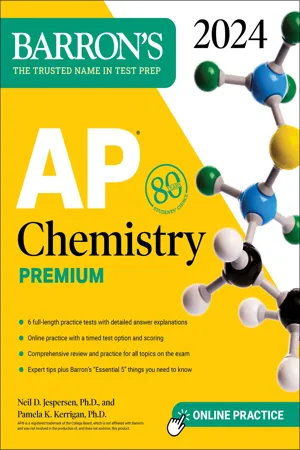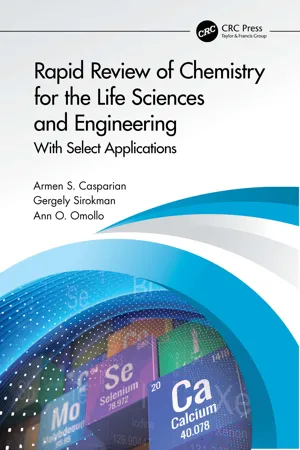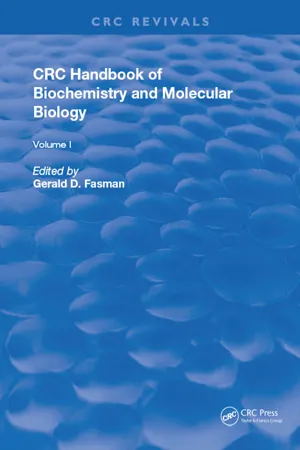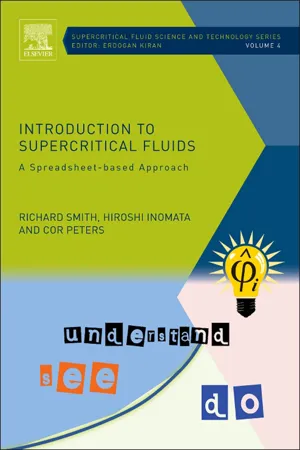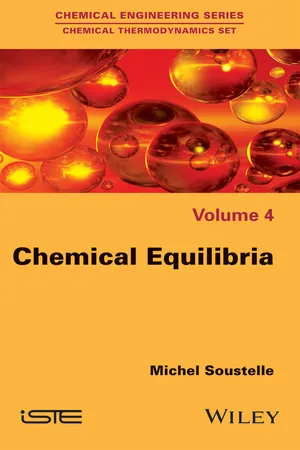Chemistry
Equilibrium Constants
Equilibrium constants are numerical values that express the extent of a chemical reaction at equilibrium. They are calculated from the concentrations of reactants and products at equilibrium and are used to predict the direction of a reaction and its equilibrium position. The value of the equilibrium constant provides information about the relative amounts of reactants and products at equilibrium.
Written by Perlego with AI-assistance
Related key terms
Related key terms
1 of 4
Related key terms
1 of 3
10 Key excerpts on "Equilibrium Constants"
- No longer available |Learn more
- Steven Boone, Drew H. Wolfe(Authors)
- 2011(Publication Date)
- Collins Reference(Publisher)
c . The equilibrium constant equals the product of the molar concentrations of the products, each raised to the power that corresponds to their coefficients in the balanced equation, divided by the product of the molar concentrations of the reactants, each raised to the power corresponding to their coefficients. Equilibria that have reactants and products in more than one phase are heterogeneous equilibria, and those in which all substances in one phase are homogeneous equilibria.If the value of the equilibrium constant is greater than one (K c > 1), the magnitude of the numerator (products) of the equilibrium expression is larger than that of those of the reactants. If the value of K c is less than one (K < 1), the equilibrium concentrations of the reactants are usually greater than those of the products.Equilibrium Constants for gas-phase equilibria are often expressed in terms of their partial pressures. This is known as the K p equilibrium constant. The following equation shows the relationship of K p to K c .K p = K c (RT) ΔnEquilibrium Constants are obtained by measuring the equilibrium concentrations or partial pressures of each component of an equilibrium mixture and substituting these values into the equilibrium expression.Before a system reaches equilibrium, the concentrations or partial pressures are expressed in terms of the reaction quotient, Q . The expression for Q is in the same form as that of K . The value of Q is used to determine the direction from which an equilibrium develops. Concentration, pressure, volume, and temperature changes affect the concentrations of the components of a chemical equilibrium. Their effects may be predicted by the application of Le Chatelier’s Principle, which states that equilibrium systems tend to absorb any changes that may occur in such a way to reduce the change and return to a state of equilibrium.Test Yourself1. Write the equilibrium expression for the following. - No longer available |Learn more
- Neil D. Jespersen, Pamela Kerrigan(Authors)
- 2023(Publication Date)
- Barrons Educational Services(Publisher)
chemical equilibrium.Figure 9.1 The two regions of chemical reactions. On the left, in the kinetic region, concentrations are changing with time. On the right, in the equilibrium region, the concentrations, on a macroscopic or laboratory scale, no longer appear to change.The Equilibrium ExpressionIn a chemical reaction the actual concentrations of the reactants and products, at equilibrium, are dependent on the initial concentrations of the reacting mixture. When several experiments with different initial concentrations of reactants are performed, they result in equilibrium mixtures with different concentrations. Although these mixtures may be different, they all obey the equilibrium expression. This law states that the concentrations of all of the products multiplied together, divided by the concentrations of all the reactants multiplied together, will be equal to a number called the equilibrium constant, K. The value of the equilibrium constant depends only on the specific reaction and the temperature of the reaction mixture when equilibrium is reached.The equilibrium expression is also called the law of mass action.TIPThe uppercase letter K is reserved as the symbol for the equilibrium constant. To describe the type of equilibrium constant a subscript is often used after the K. The symbol Kc represents the equilibrium constant when concentration is expressed in molarity units (mol L− 1 ). The symbol Kp is used when the partial pressures of gases represent the amounts of reactants and products. Special symbols for the equilibrium constant are Ksp for the solubility product, Ka for the acid ionization constant, and Kb for the base ionization constant. These special forms of K are described in later sections of this chapter.The equilibrium expression is often called the equilibrium law. Scientific laws are often equations.TIP - eBook - ePub
Rapid Review of Chemistry for the Life Sciences and Engineering
With Select Applications
- Armen S. Casparian, Gergely Sirokman, Ann Omollo(Authors)
- 2021(Publication Date)
- CRC Press(Publisher)
4 Chemical EquilibriumDOI: 10.1201/9781003092759-44.1 Basic Concept
Reaction equations describe substances, called reactants, which when put together react and produce other different substances, called products. It may appear as if only products remain after the reaction is finished. In reality, many reactions do not go to completion, even if the reactants are present in stoichiometric ratios or amounts. Rather, they reach a condition known as equilibrium, denoted by double, reversible arrows in the reaction equation. Equilibrium means that there is a balance between the reactant side and the product side, or simply between the reactants and the products, and that the reaction is reversible. The chemistry of many air pollutants falls and many bodily functions under the heading of equilibrium reactions. The equilibrium condition is dynamic, not static, allowing microscopic changes in reactant and product concentrations to take place, such that no net change in reactant or product concentrations occurs, provided that no external stresses are applied. At any given time, all species in the reaction equation—reactants and products—are present at equilibrium in varying amounts. The relationship among these varying amounts can be described by a mathematical formula known as the equilibrium constant expression or simply the equilibrium expression. The equilibrium expression is set equal to an equilibrium constant symbolized by Kc .An equilibrium reaction can be generally represented as follows:a A + b B ⇋ g G + h H(4.1)The Kc expression can then be expressed as follows:(4.2)K c=[ G ]g[ H ]h[ A ]a[ B ]bwhere a, b, g, and h represent the stoichiometric coefficients in the balanced reaction, and the brackets [ ] indicate molar concentrations. The simplest interpretation of Kc is that it is a measure of the extent to which a reaction goes toward completion, i.e., a reaction where the product side is favored. The meaning of Kc - eBook - ePub
Handbook of Biochemistry
Section D Physical Chemical Data, Volume I
- Gerald D Fasman(Author)
- 2018(Publication Date)
- CRC Press(Publisher)
We offer in this report several recommendations with the aim of increasing the usefulness of biochemical equilibrium data and coordinating the results of different investigators. These recommendations include a set of standard conditions which would facilitate the attainment of a common body of knowledge of a wide range of biochemical equilibria. This does not preclude the choice of special experimental conditions that may be appropriate for certain reactions; but whenever possible these reactions should also be studied under the recommended standard conditions. To avoid confusion in interpretation we also recommend standardization of terminology, symbols, and units in the presentation of such data.For other discussions of the presentation of numerical data and of thermodynamic data derived from experiments, we call the attention of the reader to guides prepared by CODATA1 and IUPAC.2PART I. STANDARD CONDITIONS FOR EQUILIBRIUM MEASUREMENTSTrue thermodynamic Equilibrium Constants are defined in terms of activities of the reactants and products. In many systems of biochemical interest it is not possible to evaluate the activities of all components. It is, therefore, frequently necessary to calculate Equilibrium Constants in terms of concentrations. The proper quotient of equilibrium concentrations is acceptably constant for many purposes, and will be referred to in this document as the concentration equilibrium constant, with the symbol Kc . However, it should be recognized that values for such Equilibrium Constants, Kc , and corresponding Gibbs energy changes,Δ, may not be truly constant as the composition of the system is changed.*G c o - eBook - ePub
- Jeffrey Gaffney, Nancy Marley(Authors)
- 2017(Publication Date)
- Elsevier(Publisher)
Section 5.2 , the equilibrium constant for a reversible reaction is expressed as the ratio of the equilibrium concentrations of the products in the numerator to the equilibrium concentrations of the reactants in the denominator. The superscript letters are the stoichiometric coefficients of the reactants and products in the balanced chemical equation. The exact form of an equilibrium constant expression for any reversible reaction is determined according to the following rules:1. All concentrations (indicated by square brackets) must be equilibrium values.2. The concentrations of the products are written in the numerator.3. The concentrations of the reactants are written in the denominator.4. For homogeneous reactions, the numerator contains a term for every reactant and the denominator contains a term for every product.5. For heterogeneous reactions involving a solid as reactant or product, the concentration of the solid is not included in the equilibrium constant expression.6. For heterogeneous reactions involving a liquid that acts both as a solvent and as a reactant or product, the concentration of the liquid is not included in the equilibrium constant expression.7. The concentrations of the products and the reactants are raised to a power equal to the stoichiometric coefficient in the balanced chemical equation for the reversible chemical reaction.Rule 4 includes the restriction that the reaction be homogeneous. Homogeneous reactions are chemical reactions that involve reactants and products all present in the same phase. This usually occurs where reactants and products are all in the gas phase or are all in the solution phase. A heterogeneous reaction is one that has reactants and/or products that are present in more than one phase, such as reactions involving liquids and gases, or liquids and solids. The exceptions that apply to equilibrium constant expressions for heterogeneous reactions are outlined in rules 5 and 6.According to rule 5, reversible reactions involving a solid as a reactant or product do not include the concentration of the solid in the equilibrium constant expression. For example, the reaction of hot steam with carbon in a closed container yields hydrogen and carbon monoxide gas; - eBook - ePub
- Louis Theodore, Francesco Ricci, Timothy Vanvliet(Authors)
- 2011(Publication Date)
- Wiley-AIChE(Publisher)
Most reactions have an opposing (or reverse) reaction. The rates of the forward and reverse reactions determine the equilibrium distribution of the reactants and products. Consider once again the authors’ favorite elementary reversible reaction(13.9)The elementary rate law of the forward reaction for A is(13.10)where k A is the forward reaction velocity constant for the forward reaction. For the reverse reaction(13.11)where k’ A is the reaction velocity constant for the reverse reaction. At equilibrium, the rate of production of A is just equal to the rate of consumption or disappearance of A so that, at equilibrium, the rates of production and consumption are equal, i.e.,(13.12)Combining Equations (13.10) , (13.11) , and (13.12) gives(13.13)or(13.14)The ratio of these rate constants is defined as the chemical reaction equilibrium (CRE) constant K based on concentration, i.e.,(13.15)This equilibrium constant may be measured experimentally, or obtained directly from rate constants. The reader should note that the equilibrium constant above is based on concentrations. It is very specific and is limited in application to some liquid phase reactions.The generally accepted all-purpose equilibrium constant K (also referred to as the true equilibrium constant) can be shown to be related to the previously developed standard free energy of reaction.The following equation is used to calculate the chemical reaction equilibrium constant K at a temperature T :(13.16)The value of this equilibrium constant depends on the temperature at which the equilibrium is established. The effect of temperature on K must now be examined. This is addressed in the next three sections.ILLUSTRATIVE EXAMPLE 13.6Calculate the chemical reaction equilibrium constant K for a reaction that has a ΔG value of -20.0 kcal/gmol at 70°F.SOLUTION :From Equation (13.16)with T = 70°F = 294K.For ΔG 0 = -20.0 kcal/gmolThis low value of K suggests an extremely high conversion of reactants. Details on conversion calculations are provided in the next chapter. - eBook - ePub
- Roger C. Viadero, Jr.(Authors)
- 2023(Publication Date)
- CRC Press(Publisher)
f = forward reaction rate constant. If the unit of reaction rate is mol/time, the units of the equilibrium reaction constant will depend on the values of a and b in Equation 5.2.Equation 5.3r r= −k rC cD dwhere rr = reverse reaction rate and kr = reverse reaction rate constant.When a reacting chemical system reaches equilibrium, the forward and reverse reaction rates are constant. In this case, the reaction is characterized by the equilibrium reaction constant, Keq. For a single-step reversible reaction at equilibrium, we can equate Equation 5.2 and Equation 5.3 and write the equilibrium constant, Keq , in terms of product and reactant concentrations raised to their respective stoichiometric coefficients as in Equation 5.4.Equation 5.4The equilibrium reaction constant is a function of environmental conditions, including temperature, pressure, and ionic strength.K=e qC cD dA aB b5.2 Chemical Kinetics
Previously, we considered the case where equilibrium was reached in a chemical reaction. Now, we need to examine the case where equilibrium between reactants and products hasn’t been reached, so net changes in their respective concentrations occur over time. Recall the balanced chemical reaction presented previously in Equation 5.1. We can write a general expression for the rate at which the reaction occurs, r, according to Equation 5.5.Equation 5.5where w, x, y, and z are coefficients determined through lab studies. The unit for r is mol/l∙s while the units of k are a function of the values of w, x, y, and z.r = − kA wB xC yD zThe overall order of a reaction is determined by adding the coefficients in Equation 5.5. The order of a reaction with respect to an individual product or reactant is determined by the exponent associated with a particular species. In our general reaction rate expression, the reaction is w order in A, x order in B, y order in C, and z order - eBook - ePub
Introduction to Supercritical Fluids
A Spreadsheet-based Approach
- Richard Smith, Hiroshi Inomata, Cor Peters(Authors)
- 2013(Publication Date)
- Elsevier Science(Publisher)
Chapter 9Chemical Equilibria and Reaction Kinetics
Richard Smith, Cor Peters and Hiroshi Inomata Logic will get you from A to B. Imagination will take you everywhere. Albert Einstein (1879–1955)Tip Box#1 Chapter objectives(1) to review key concepts in thermochemistry (2) to introduce methods for analyzing chemical equilibria (3) to show the effect of nonidealities on “real world” chemical equilibria (4) to introduce thermodynamic analysis of chemical reactors (5) to show how reaction kinetics are used to model reaction pathways9.1 Overview
Chemical equilibria gives one the composition of a reaction system in its most stable state, whereas reaction kinetics gives one the rate at which the chemical species are transformed from their initial state to a final state. Analysis of chemical equilibria helps one to understand the limits of a reaction according to its thermodynamics and the given reaction conditions. Analysis of reaction kinetics helps one to understand how long it will take to make the transformation in reality. Detailed development of chemical equilibria theory is given in many excellent undergraduate textbooks in chemical thermodynamics [CT1 –CT3] and chemical reactions [CT4] .With any type of chemical reaction or process, energy transfer occurs and this is the basis of thermochemistry. The energy transfer of a reaction is described by thermochemical equations, which are balanced stoichiometric equations for the reactant and product chemical compounds. Thermochemical equations are written in terms of the moles of each chemical compound, for example:(9.1)The a and b are stoichiometric coefficients that represent the moles of reactant chemical compounds A and B , respectively, required to form c moles of product chemical compound C . When changes in properties are calculated by treating Eq. (9.1) as a mathematical equation, by convention, the stoichiometric coefficients are positive (+) for products and negative (−) for reactants . Thus, the change in enthalpy of Eq. (9.1) - eBook - ePub
- Adrian Dingle, Derrick C. Wood(Authors)
- 2014(Publication Date)
- Research & Education Association(Publisher)
concentrations of reactants and products. In fact, they are very rarely the same numerical value.
5. Graphically, the concentrations of reactants and products can be represented as: i. For a product-favored reaction: ii. For a reactant-favored reaction: C. Quantitative TreatmentAll concentrations being constant (not changing) is not the same thing as concentrations being equal (all having the same value). This is a common misconception and one that you must not have.1. Equilibrium Constants for gaseous reactions: Kp , Kci. Equilibrium constant relates the concentrations of reactants and products at equilibrium at a given temperature.For the general reaction: aA + bB cC + dDThe equilibrium constantProduct molar concentrations are in the numerator.Reactant molar concentrations are in the denominator.Each concentration is raised to the power of its stoichiometric coefficient in the balanced chemical equation.Pure solids and pure liquids (e.g., water) are not placed into the expression.The expression Kc indicates that concentrations are used (moles per liter).The expression Kp indicates that partial pressures are used (pressure units, often atm) and only gases are included.Examples1. N2 (g) + 3H2 (g) 2NH3 - eBook - ePub
- Michel Soustelle(Author)
- 2015(Publication Date)
- Wiley-ISTE(Publisher)
4 Determination of the Values Associated with Reactions – Equilibrium CalculationsThe objective of this chapter is, by experimentation or computation, on the basis of the values of the main properties, to determine the value of the equilibrium constant of a reaction, or, which is the same thing by virtue of relation [4.2 ], that of the standard molar Gibbs energy associated with the reaction in question.We shall then examine the use of those values to calculate complex equilibria, enabling us to define domains of stability of the phases and the compounds, domains of predominance of components, and to serve the ultimate goal of a transformation within the system.In this chapter, we only look at molecular reactions. Ionic equilibria will be studied in Volume 6 of this Set of books.4.1. Reminders of a few thermodynamic relations
In this section, we shall establish a certain number of thermodynamic relations specific to the reactions, which will be useful to us in this chapter, particularly, for calculating the values.Remember that every time we attempt to determine an equilibrium constant, we need to begin by choosing the constant in question (see section 3.1.2
Index pages curate the most relevant extracts from our library of academic textbooks. They’ve been created using an in-house natural language model (NLM), each adding context and meaning to key research topics.
Explore more topic indexes
Explore more topic indexes
1 of 6
Explore more topic indexes
1 of 4

